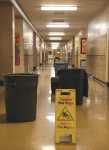Committee recommends plant facility levy

A committee of local parents is urging the Mountain Home School District to move forward with plans calling for a plant facility levy later this summer as the district struggles to make urgent repairs to its buildings.
During a school board meeting last month, the four-person committee submitted a recommendation calling for a $5 million plant facility levy that would appear on the district's Aug. 19 election ballot.
Last October, the school board organized the committee to specifically look at maintenance issues at each school. Topping the list of issues was the roof at Hacker Middle School, which leaks each time it rains or snows.
The committee included parents with children enrolled in the local school district. They came together shortly after heavy rains last October leaked through the middle school roof with water seeping into its hallways and classrooms.
It wasn't the first time that roofs in local area schools have leaked. In January 2012, a winter storm that dumped heavy snow in the Mountain Home area caused similar damage inside the middle school as the snow melted.
Like most schools in the district, Hacker has a flat versus pitched roof. When the rain and snow falls, the water simply had no place to go.
In 2013, the district had enough money to repair the roof at the middle school. However, it ended up using those funds to make urgent repairs to the school's 56-year-old boiler.
While the four-person board was originally tasked with finding solutions for dealing with the middle school roof, their effort extended into addressing safety issues at other district buildings, said district assistant superintendent James Gilbert.
"The committee felt pretty adamant that there are a list of safety items that need to be fixed in the district, starting with the Hacker roof," Gilbert said.
In addition to electrical wiring issues in some buildings, the district's older facilities still have asbestos in the walls. Meanwhile, the asphalt pavement in some school playgrounds is crumbling.
The average age of the district's seven original school buildings is nearly 57 years. Bennett Mountain High School is the district's oldest at nearly 87 years old while Mountain Home Junior High School is the newest at 17 years.
The five-year plant facility levy proposal submitted by the committee would total $1 million annually over a five-year period.
"That works out fairly well because we're about to retire the 1995 bonds on the junior high school building," said Mountain Home School District board president Jim Alexander. "We felt that we can dovetail the new levy with that old one so that the change in taxation shouldn't be dramatic."
According to Alexander, the plant facility levy would be "more of a continuation of the amount that people have already been paying."
Regarding the middle school roof, Alexander emphasized that the committee's recommendation is just a preliminary plan. District officials still needs firm numbers on how much it will cost to fix that roof in addition to other repairs attributed to the water damage at the school.
The plant facility levy is expected to be included in the Aug. 19 school district election. It's the same type of levy that local voters had continuously approved since the 1950s, failing only one before during this time.
In 2011, however, voters rejected a five-year plant facility levy of $950,000 per year. When that measure failed, the district ended up having to make do with "bandage fixes" to maintain its buildings, district officials said.
At the same time, the committee included within its recommendation a long-range plan aimed at eventually building a new high school in Mountain Home.
The committee's recommendation to the school board came just days before test results showed low levels of mold inside the middle school. An independent study conducted in late February inside two classrooms and a main hallway detected the presence of common mold like aspergillus and penicillium -- the same spores found in moldy bread.
However, the levels recorded in these tests were within established environmental safety guidelines, according to Alexander. It compares to the types and levels of mold spores in other buildings across Mountain Home.
"There is no significant mold issue," Gilbert said. "The data confirmed that it's safe to have kids, and teachers and staff inside that building."
But at the same time, the mold is unsightly and has an unpleasant smell, which Alexander said was unacceptable.
"We need to fix it for the structural integrity of the building," the school board president added.
The findings of the mold study were presented to the middle school faculty on Monday.
